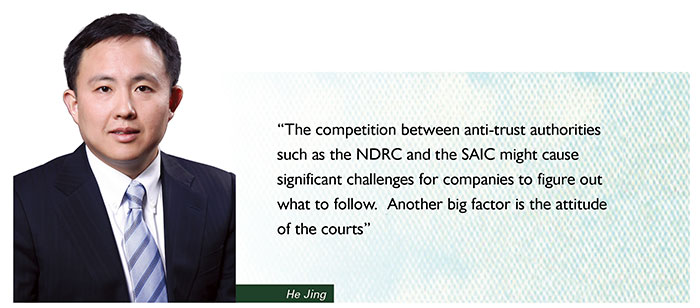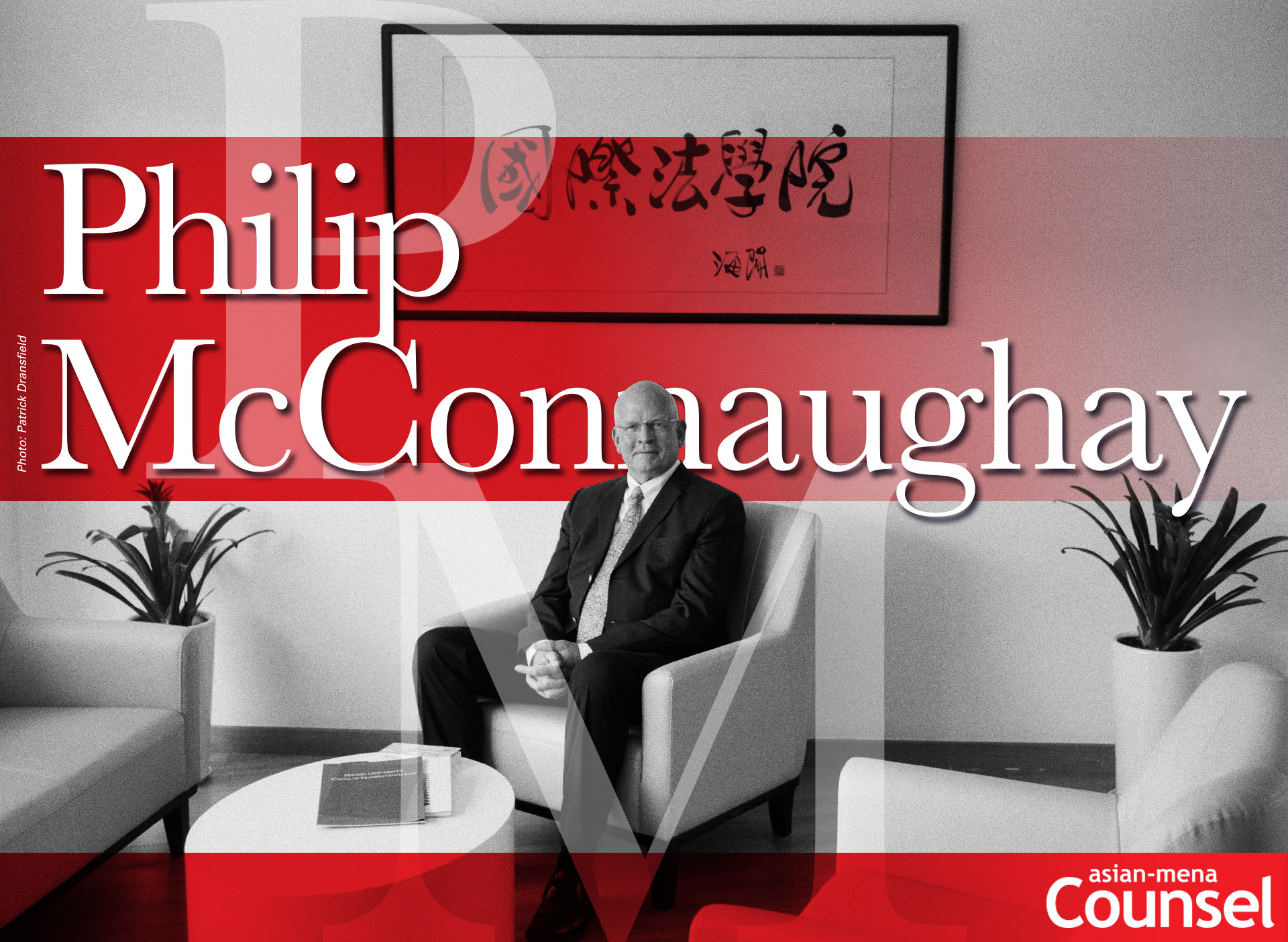He Jing of Anjie Law Firm gives history and case studies of China’s anti-trust laws in relation to IP and asks what he feels is the ‘big question’.
Introduction
Intellectual property (IP) related anti-trust enforcement in China has been a focal point among the industries and the international anti-trust legal community for last couple of years. The Qualcomm investigation by the National Development and Reform Commission (NDRC) is symbolic of what a large licensing company may encounter in China.
This brief will highlight the key events and the most relevant legal basis in the IP-related anti-trust fields in China. Some of our readers may be surprised to discover the breadth and depth of the legal and business issues that have been addressed by the Chinese courts. Standards-related IP policies, FRAND royalty rates, refusal to license, patent pools, injunction relief for standard essential patents, etc. have been heatedly debated among policy makers, judges, practitioners and industries. Some Chinese court cases are arguably among the very early decisions worldwide. The future enforcement activities and outcome of private anti-trust lawsuits in China may likely continue impacting the trends.
Early history
China did not have its Anti-monopoly Law (AML) until 2008. Prior to that, courts and government authorities relied on the Anti-unfair Competition Law, which includes rules dealing with bundling, to address anti-competitive activities.
Back in 2004, a Chinese generic battery company TSUM sued SONY Corp. for illegal bundling of its infoLITHIUM batteries. This case was widely held as the first IP anti-competitive court case as the plaintiff argued that Sony misused its encryption technology to bundle the batteries. The court dismissed the plaintiff’s claim and ruled there were no tie-ins.
IP-related anti-trust issues were given much deeper thought when China started experimenting patent pooling efforts for homegrown standards in 2004. The widely known video codecs group AVS took an unusual move in setting out an IPR policy for standardisation setting activities. Issues such as FRAND and Standard Essential Patents were seriously considered and eventually addressed in the carefully drafted IPR policy. Multinational companies’ standard experts and IP counsel contribute significantly to this effort, although the commercialisation of the AVS standards was not that successful.
Between 2004 and 2014, lots of IP-related anti-trust discussions focussed on IP policy for standard-setting activities. The draft measures on national standards related to patent rules, which were driven by the Standard Administration Commission, consistently attracted the interest of the industries until the rules were finally issued in 2014.
Anti-monopoly Law
What shifted the legal landscape is the PRC Anti-monopoly Law, which went into effect as of August 1, 2008. Its Article 55 directly addresses intellectual property rights. Although Art. 55 seems to acknowledge that IPR owners are entitled to exercise IP rights, it essentially subjects any alleged IP misuse to the jurisdictions of the anti-monopoly law. The very provision lays out the statutory basis for subsequent legislative efforts in IP misuse fields. Another signficiance is that the PRC AML provides the legal basis for private anti-trust lawsuits for civil remedies. Everyone has been watching how the courts and the anti-trust regulators in China are going to handle the IP misuse cases.
After the passage of the AML, legislative efforts in an IP-related field mostly relate to the IP Misuse Guidelines that were being drafted by the State Administration for Industry and Commerce (SAIC). The guidelines were eventually converted into the IP Misuse Measures, which we will described in more detail in the briefing.
Notably, the Supreme People’s Court (SPC) issued advisory opinions on determination of royalty rates for those standard essential patents in the same period of time. While the opinions were not binding, it is clear that SPC has deep interest in setting out clear precedents in this area. A more active SPC is expected to have a much bigger impact in this field in the years to come.
MOFCOM’s 2012 merger review of Google and Motorola
The first China case where PRC anti-monopoly law authorities made clear their position and analysis on standard essential patents is probably the MOFCOM merger review in Google’s acquisition of Motorola. In May 2012, MOFCOM announced its conditional approval of Google Inc.’s proposed US$12.5 billion acquisition of Motorola Mobility Holdings Inc. Contrary to the unconditional approval granted by the EU and US anti-trust authorities, MOFCOM imposed the conditions on Google out of anti-trust concerns. Such conditions include: Google shall treat all OEMs in a non-discriminatory manner with regard to the Android platform; and Google shall honour Motorola’s pre-existing commitment to license its SEPs on FRAND terms.
Huawei Technologies v. InterDigital Corporation
The Huawei cases are probably among the most controversial decisions. The decisions related to the determination of relevant market and FRAND royalty rates have generated countless debates, which may even hurt Huawei’s own licensing activities in the future.
In April 2014, the Guangdong High Court of China published its October 2013 judgments in two Huawei Technologies v. InterDigital Corporation cases. Huawei, the world’s largest telecommunications manufacturer, prevailed in its two claims that US-based InterDigital Corporation (IDC) abused its dominant market position and failed to license its SEPs on FRAND terms.
Regarding the first claim, the court supported Huawei’s claim that IDC had abused its dominant market position by mandating a tying arrangement in the licence agreements, requiring grant-backs, and requesting a discriminatory and unreasonably high royalty rate for its Chinese SEPs and non-SEPs. In particular, the court found that each of the SEP licensing markets constitutes a relevant market.
Regarding the second claim, the Guangdong High Court affirmed the Shenzhen Intermediate Court’s ruling that IDC imposed excessively high royalty rates for its SEPs related to 2G, 3G, and 4G wireless communications standards. Specifically, the court found that IDC’s royalty rates were noticeably higher when compared to IDC’s licensing agreements with Apple and Samsung. However, many people believe that the royalty rate lacks sufficient grounds, as the alleged royalty rate IDC charged Apple is not really comparable. The case is currently pending at the Supreme People’s Court for a final review.
The NDRC’s 2013 investigation of Qualcomm
In February 2015, the NDRC concluded its investigation of Qualcomm Corporation and imposed a RMB6.088 billion fine on Qualcomm, the largest penalty to date under China’s Anti-Monopoly Law. The NDRC identified three types of anti-competitive conduct that Qualcomm engaged in during its licensing arrangements with Chinese licensees:
- Charging excessive licensing rates;
- Bundling the licensing of SEPs with non-SEPs without justification; and
- mposing unreasonable terms and conditions in licensing agreements without justification.
Notably, in this decision, the NDRC seems to have followed some of the legal analysis under the Huawei cases when it comes to the abuse of dominant market position in licensing activities. The most significant outcome of this case, from anti-trust perspectives, is that Qualcomm has escaped the worst nightmare – in this case, application of smallest salable items doctrine. In other words, the PRC anti-trust authority does not object to Qualcomm continuing to charge royalty based on the handset price.
 |
MOFCOM’s 2014 merger review of Microsoft and Nokia
This merger review decision deserves a lot more attention than it has received as the decision deals with some of the most challenging issues related to de facto essential patents.
In April 2014, just two years after its conditional approval of the Google merger discussed above, MOFCOM approved Microsoft’s acquisition of Nokia’s mobile handset business on the condition that both Microsoft and Nokia continued their business dealings with licensees on FRAND terms. MOFCOM expressed concerns that Microsoft—after obtaining control of the sizable mobile devices manufacturer—might take advantage of its “important patents”, e.g. those covering Android operating system, in order to gain a competitive advantage over other competitors in the mobile handset market—particularly other Android phones. This raises a very interesting issue about whether PRC authority believes that FRAND should apply to de facto essential patents.
SAIC IP abuse rules
The SAIC released the long-awaited Rules on the Prohibition of Abuse of Intellectual Property Rights for the Purpose of Eliminating or Restricting Competition (SAIC IPR Abuse Rules) on April 7, 2015, which will be effective as of August 1, 2015. The SIAC IPR Abuse Rules deal with manifold issues such as the determination of a patent holder’s market dominance, compulsory licensing, standard essential patents (SEP), safe harbour in horizontal and vertical agreements settings, etc.
The SAIC IPR Abuse Rules were initially drafted as guidelines to deal with IP-related anti-competitive practices, a project which was commenced as early as 2009. The earlier drafts of the guidelines were commented on multiple times by local and foreign legal professionals, regulatory agencies, courts and other stake-holders. At the end of 2012, the SAIC made a dramatic move to convert the draft guidelines into the SAIC IPR Abuse Rules, which can act as the legal basis for the SAIC imposing penalties on violators.
However, the fate of the SAIC IPR Abuse Rules was cast into doubts when the State Council Anti-monopoly Commission announced in early June 2015 that NDRC has been delegated to draft IP misuse guidelines. It is perplexing how the two sets of IP misuse rules will be applied in practice. While the industries and practitioners are now waiting to see the first draft of the new IPR misuse guideline, it may be useful to review some of the key provisions in the SAIC IPR Abuse Rules, as these rules arguably presented the most comprehensive legal framework to handle IP-related anti-trust issues.
(1) A Rule of reason approach
The wording of the SAIC IPR Abuse Rules seems to suggest that the authority has endorsed a rule of reason approach, which provides much greater flexibility as opposed to a per se approach.
(2) Relevant (technology) market
In addition to defining the anti-trust concept of the “relevant market” as both the “product market” and “geographic market”, Article 3 of the IP Abuse Rules stipulates that the relevant market may also refer to a “technology market”—or a product market involving certain IPRs. Specifically, the “relevant technology market” refers to the market that is developed out of competition between the technology involved in exercising IPRs and any available substitutable technology of similar capacity to produce similar goods.
(3) Exceptions to anti-trust liability regarding certain agreements
Article 5 of the IPR Abuse Rules stipulates legal exceptions to anti-trust liability in the context of IP with regards to certain vertical and horizontal agreements. Specifically, the provision states that the SAIC shall not find anti-trust liability in the following circumstances:
- Horizontal agreements: either the combined market share of the competing business operators in the relevant market does not exceed 20 percent; or there exist at least four independently controlled substitutable technologies that are available at reasonable cost in the relevant market.
- Vertical agreements: either the respective market share of each of the business operators and their transaction counterparties in the relevant market does not exceed 30 percent; or there exist at least two independently controlled substitutable technologies that are available at a reasonable cost in the relevant market.
(4) Presuming a dominant market position as a result of holding IPRs
In-house counsel should take solace in the fact that Article 6 of the IP Abuse Rules clearly stipulates that the SAIC shall not presume that IP holders have a dominant market position by merely holding IPRs. This provision also carries over into the discussion of standard essential patents (SEPs). In effect, it should provide a layer of protection for IP holders and make it harder for the SAIC to prove that the holder has a dominant market position.
(5) The essential facilities doctrine
The SAIC adopts the controversial essential facilities doctrine, despite repeated suggestions from the United States’ American Bar Association and other foreign legal entities to exclude the doctrine. In essence, Article 7—the essential facilities provision—stipulates that a business operator in a dominant market position must license its patent to other competitors when the patent at issue is deemed an “essential facility”, regardless of an IPR of unilateral exclusion. In determining whether a patent is an essential facility, there is a three-prong test:
- The IP at issue cannot be reasonably substituted in the relevant market, and it is essential for other business operators to compete in the relevant market;
- A refusal to license will adversely affect competition or innovation in the relevant market, thereby harming consumers or the public interest; and
- Compulsory licensing of the IP at issue will not cause unreasonable harm to the IP holder.
The SAIC clearly realises the controversies here. One of its senior officials has repeatedly assured the industries that the authority will be very much cautious in using this provision.
(6) SEPs and FRAND
Article 13 expressly prohibits holders of essential patents from taking advantage of standard-setting organisations (SSOs) and failing to disclose their IPRs to SSOs when they choose to adopt a standard involving their IPR. Furthermore, the provision states that SEP holders must license the SEP on FRAND grounds.
Conclusion
It is clear that China is rapidly developing rules on IP-related anti-trust issues. The competition between anti-trust authorities such as the NDRC and the SAIC might cause significant challenges for companies to figure out what to follow. Another big factor is the attitude of the courts. As more private anti-trust lawsuits are being filed, the Supreme People’s Court may be willing to use its powers to issue specific rules or otherwise use leading precedents to set the tone. The Supreme Court published a draft for public comments of the judicial interpretation on patent lawsuits. Several provisions directly address injunctions related to SEP. Will the PRC courts follow something close to competition-neutrality or show more interest in protecting local firms? This is a big question.
Email: hejing@anjielaw.com
Website: www.anjielaw.com




















